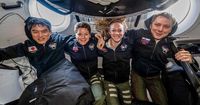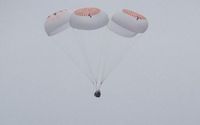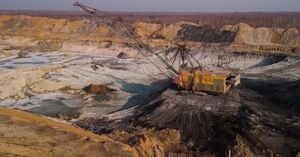In a dramatic and historic homecoming, four astronauts safely splashed down in the Pacific Ocean off the coast of San Diego on Saturday, August 9, 2025, concluding a mission that was as eventful as it was groundbreaking. After five months aboard the International Space Station (ISS), NASA’s Crew-10—comprising NASA astronauts Anne McClain and Nichole Ayers, Japan Aerospace Exploration Agency (JAXA) astronaut Takuya Onishi, and Roscosmos cosmonaut Kirill Peskov—returned to Earth in SpaceX’s Dragon spacecraft, marking the first time in half a century that a NASA crewed mission ended in the Pacific.
The journey home began the previous evening, when the Dragon capsule undocked from the ISS at 6:05 p.m. EDT on Friday, August 8. Over the next 17 hours, the spacecraft performed a series of precisely choreographed orbit-lowering maneuvers before re-entering Earth’s atmosphere. At 11:33 a.m. PDT (1533 GMT) on Saturday, the capsule parachuted into the Pacific, just off Southern California. All four astronauts were reported to be in good health following their recovery, according to SpaceX and NASA statements reported by FOX 5/KUSI and Newsweek.
The mission was significant for several reasons, not least because Crew-10 had launched in March 2025 as replacements for two NASA astronauts originally assigned to Boeing’s Starliner test flight. That mission had gone awry when Starliner experienced a series of malfunctions, stranding test pilots Sunita “Suni” Williams and Barry “Butch” Wilmore at the ISS for more than nine months—far longer than their planned week-long stay. NASA subsequently ordered the Starliner to return empty and arranged for Wilmore and Williams to come home via SpaceX. Wilmore has since retired from NASA, closing a dramatic chapter in the agency’s human spaceflight efforts, as noted by the Associated Press.
For Crew-10, the five months in orbit were packed with activity. The team conducted more than 200 experiments and technology demonstrations, ranging from spacewalks and lightning observations to DNA tip testing and microscopic motion studies. According to NASA, the research included studies of plant growth, cell behavior in microgravity, blood flow, and human physiological changes—work considered vital for advancing future human space exploration and improving life on Earth. As Space.com and Newsweek highlighted, these investigations will continue to be analyzed over the coming months, with long-term studies planned to assess the astronauts’ health and the impact of microgravity on their bodies.
Anne McClain, who served as commander for the mission, reflected on the experience and its broader significance. Before leaving the ISS, she acknowledged the challenges facing people on Earth, stating, “We want this mission, our mission, to be a reminder of what people can do when we work together, when we explore together.” Upon splashdown, she summed up the adventure simply: “It was truly the ride of a lifetime. From the entire Crew-10, thank you. It was truly the ride of a lifetime.” (Associated Press, Newsweek).
Nichole Ayers, the mission’s pilot, shared her gratitude and optimism about the future of space exploration. “We got to accomplish a lot of really amazing operational things. We got to see some amazing views, and we have had some really big belly laughs and a wonderful time together. I think that [we’re] leaving with a heart full of gratitude, and [we’re] excited to see where the International Space Station goes after we get home,” she said, as quoted by Space.com.
The return marked a series of firsts and milestones. While SpaceX had previously performed two Pacific splashdowns with private crews, this was the first for a NASA crew since the 1975 Apollo-Soyuz mission—a symbolic handshake in orbit between American and Soviet astronauts at the height of the Cold War. Earlier this year, SpaceX made the strategic decision to switch capsule returns from Florida to California, aiming to reduce the risk of debris falling over populated areas. The move paid off, and the successful conclusion of Crew-10’s journey underscored the maturation of commercial partnerships in human spaceflight, as noted by FOX 5/KUSI and Newsweek.
The mission also showcased the reliability and reusability of SpaceX’s hardware. The Dragon spacecraft used for Crew-10 had previously flown three other NASA missions—Crew-3, Crew-5, and Crew-7—while the Falcon 9 rocket that launched Crew-10 had already completed a prior flight, demonstrating SpaceX’s commitment to sustainable space operations.
For the astronauts, the return to Earth brought not just scientific achievement but also personal relief and anticipation of simple pleasures. McClain looked forward to “doing nothing for a couple of days” once back home in Houston. Her crewmates, meanwhile, were eager for hot showers and juicy burgers—comforts that can seem almost otherworldly after months in microgravity. The crew’s safe exit from the capsule, broadcast live by NASA and SpaceX, was met with cheers and fist pumps, as each astronaut was able to stand and walk before being taken for medical evaluation.
After initial checks on the recovery ship, the astronauts were scheduled to be flown by helicopter back to shore, then travel by plane to reunite with their families. NASA confirmed that all four would undergo further medical assessments and that the scientific data and samples collected during their 145-day stay would be analyzed in detail in the coming months.
Crew-10’s mission was the 10th commercial crew rotation flight with SpaceX under NASA’s Commercial Crew Program, a partnership that has become the backbone of American human spaceflight since the retirement of the Space Shuttle. The program’s success has allowed NASA to maintain a continuous human presence on the ISS, while also fostering international cooperation—this time bringing together astronauts from the United States, Japan, and Russia.
As the next crew prepares for their own journey aboard Crew-11, the legacy of Crew-10 will be measured not just in scientific data, but in the renewed sense of possibility and unity their mission inspired. In a world often marked by division, the sight of four astronauts from three nations working together in orbit—and returning safely to Earth—offers a powerful reminder of what humanity can achieve when it sets its sights on the stars.





